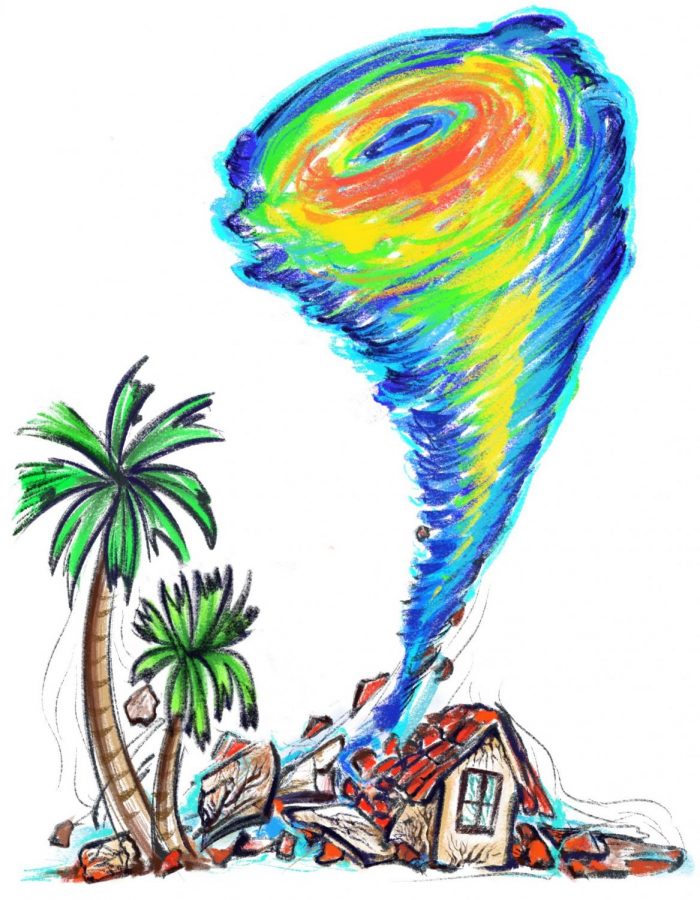Hurricane Dorian strikes coast: Rebuild process begins after 8 billion dollars in damages
Hurricane Dorian hit the Abaco Islands in the northern Bahamas on Aug. 24.
November 9, 2019
Dorian, the latest major incident of climate change, was the most intense tropical storm on record to hit the Bahamas. Causing more than seven billion dollars in damages, it is just one of the many hurricanes and cyclones that have occurred this year. As weather changes, storms escalate and the planet warms, there have been many who oppose the evident consequences that stem from disregarding global warming.
On Aug. 24, Dorian hit the Abaco Islands at a max speed of 185mph. The category five hurricane had killed over 56 people.
“Hurricane Dorian, along with other natural catastrophes, [was] worsened due to global warming,” Camilla Lindh (10), a member of the green team who attended the climate strike said. “Green Team allowed me to have a better understanding of what was happening around me in terms of climate.”
The warming of the earth can factor into the frequency, intensity, severity, and duration of natural catastrophes such as hurricanes like Dorian. According to the UCAR Center for Science Education, the sea surface temperature increased by an average of 1.5 F between 1901 and 2016. These warmer waters intensify hurricanes and tropical storms, causing faster wind speeds and high levels of inland flooding.
Aside from warmer waters, climate change also leads to higher sea levels. According to the U.S. Global Change Research Program, the global sea average has risen about three inches since 1993, out of the seven to eight-inch rise since 1900. Heightened sea levels create more flooding and push more water onto land because they cause higher storm surge levels.
But it is not just hurricanes and tropical storms that are affected by this. Different extreme weather events are intensified: for example, more drought is expected in dry places. Similarly, in wet places, there can either be more rain and moisture expected, or the same annual average of rain, but coming in shorter spurts of higher precipitation. In predictions for the future, the trend of an increase in extreme weather, drought, precipitation, flooding, hurricane and heatwave is expected to continue.
“The projections are essentially ones in which we simulate the environment, simulate global climate, and then add in what we expect to see in future scenarios in terms of say, carbon dioxide. So what we expect to see based on these simulations is just more of what we are starting to see now,” Ilian DeCorte, a third-year graduate student in the atmospheric and oceanic sciences department at UCLA said. “Essentially, in future projections, it depends on how much more emissions we emit and how well we do at taking greenhouse gases out of the atmosphere and how the oceans are interacting with that, so that’s where the variability comes in, but if we continue to release emissions, we will continue to see an increase in the phenomenon that we are seeing now.”




![LALC Vice President of External Affairs Raeanne Li (11) explains the International Phonetic Alphabet to attendees. "We decided to have more fun topics this year instead of just talking about the same things every year so our older members can also [enjoy],” Raeanne said.](https://harkeraquila.com/wp-content/uploads/2025/10/DSC_4627-1200x795.jpg)


















![“[Building nerf blasters] became this outlet of creativity for me that hasn't been matched by anything else. The process [of] making a build complete to your desire is such a painstakingly difficult process, but I've had to learn from [the skills needed from] soldering to proper painting. There's so many different options for everything, if you think about it, it exists. The best part is [that] if it doesn't exist, you can build it yourself," Ishaan Parate said.](https://harkeraquila.com/wp-content/uploads/2022/08/DSC_8149-900x604.jpg)




![“When I came into high school, I was ready to be a follower. But DECA was a game changer for me. It helped me overcome my fear of public speaking, and it's played such a major role in who I've become today. To be able to successfully lead a chapter of 150 students, an officer team and be one of the upperclassmen I once really admired is something I'm [really] proud of,” Anvitha Tummala ('21) said.](https://harkeraquila.com/wp-content/uploads/2021/07/Screen-Shot-2021-07-25-at-9.50.05-AM-900x594.png)







![“I think getting up in the morning and having a sense of purpose [is exciting]. I think without a certain amount of drive, life is kind of obsolete and mundane, and I think having that every single day is what makes each day unique and kind of makes life exciting,” Neymika Jain (12) said.](https://harkeraquila.com/wp-content/uploads/2017/06/Screen-Shot-2017-06-03-at-4.54.16-PM.png)








![“My slogan is ‘slow feet, don’t eat, and I’m hungry.’ You need to run fast to get where you are–you aren't going to get those championships if you aren't fast,” Angel Cervantes (12) said. “I want to do well in school on my tests and in track and win championships for my team. I live by that, [and] I can do that anywhere: in the classroom or on the field.”](https://harkeraquila.com/wp-content/uploads/2018/06/DSC5146-900x601.jpg)
![“[Volleyball has] taught me how to fall correctly, and another thing it taught is that you don’t have to be the best at something to be good at it. If you just hit the ball in a smart way, then it still scores points and you’re good at it. You could be a background player and still make a much bigger impact on the team than you would think,” Anya Gert (’20) said.](https://harkeraquila.com/wp-content/uploads/2020/06/AnnaGert_JinTuan_HoHPhotoEdited-600x900.jpeg)

![“I'm not nearly there yet, but [my confidence has] definitely been getting better since I was pretty shy and timid coming into Harker my freshman year. I know that there's a lot of people that are really confident in what they do, and I really admire them. Everyone's so driven and that has really pushed me to kind of try to find my own place in high school and be more confident,” Alyssa Huang (’20) said.](https://harkeraquila.com/wp-content/uploads/2020/06/AlyssaHuang_EmilyChen_HoHPhoto-900x749.jpeg)











